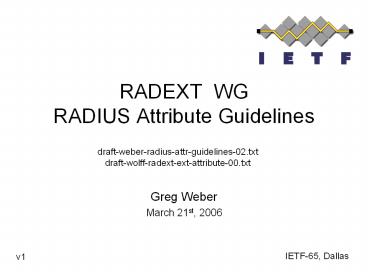RADEXT WG RADIUS Attribute Guidelines - PowerPoint PPT Presentation
Title:
RADEXT WG RADIUS Attribute Guidelines
Description:
This document will provide guidelines for design of RADIUS attributes. ... Elegance, alas. IETF-65, Dallas. 12. RADIUS Attribute Guidelines. From the Wolff draft: ... – PowerPoint PPT presentation
Number of Views:51
Avg rating:3.0/5.0
Title: RADEXT WG RADIUS Attribute Guidelines
1
RADEXT WGRADIUS Attribute Guidelines
draft-weber-radius-attr-guidelines-02.txtdraft-wo
lff-radext-ext-attribute-00.txt
- Greg Weber
- March 21st, 2006
IETF-65, Dallas
v1
2
RADIUS Attribute Guidelines
- WG Charter Item
- RADIUS design guidelines. This document will
provide guidelines for design of RADIUS
attributes. It will specifically consider how
complex data types may be introduced in a robust
manner, maintaining backwards compatibility with
existing RADIUS RFCs, across all the classes of
attributes Standard, Vendor-Specific and
SDO-Specific. In addition, it will review RADIUS
data types and associated backwards compatibility
issues. - Milestone Oct 06 completionOriginally Dec 04
Guide-01
ExtAttr-00
Guide-02
Guide-00
DraftRevisions
Milestones
IESG Submissions
WG LC1
IETF-65, Dallas
3
RADIUS Attribute Guidelines
- draft-weber-radius-attr-guidelines-02.txtdraft-wo
lff-radext-ext-attribute-00.txtdraft-evbergen-rad
ext-extended-attribute-02.txt - Aimed at charter item
- The Guidelines draft collects data points from
early radius-ext threads current behavior,
solution scope, and guidelines - The Wolff draft proposes a Diameter-based
encoding - The Van Bergen draft proposes a RADIUS-like
tagging mechanism - Have you read the drafts? -)
IETF-65, Dallas
4
RADIUS Attribute Guidelines
- Motivation why do we need guidelines?
- Divergent data models
- Attribute space exhaustion
- Diameter alignment
IETF-65, Dallas
5
RADIUS Attribute Guidelines
- Data Model
- Two attribute spaces standard vendor
- Small number of data types
- Consistent TLV payload use enables
- interoperability, intermediate nodes (proxies)
- simple implementation attributes can be added
without new parsing code - Many exceptions
Simple TLV
IETF-65, Dallas
6
RADIUS Attribute Guidelines
- Data Model Alignment
- Vendor space somewhat varied -)
Vendor
PacketCable
Vendor
Vendor
3GPPVSAs
Microsoft
3GPP2
Tags
Vendor
3GPP2
FRAGMENT
ENCRYPT
COMPACT
SHARED
Simple TLV
COMPLEX DATA
GROUPING
IETF-65, Dallas
7
RADIUS Attribute Guidelines
- Scope
- Backwards compatibility
- Intermediate nodes
- Dictionary based implementations
- Unaware endpoints
- Existing VSA usage
- Transport Impact
- Non-AAA applications
- Diameter compatibility
IETF-65, Dallas
8
RADIUS Attribute Guidelines
- New Section 7 new attributes SHOULD comply with
the attribute design guidelines given in RFC 2865
unless one or more of the following applies - The standard attribute space for new attributes
has been exhausted. - The proposed maximum attribute length exceeds
that available for attributes specified by RFC
2865. - The native data type of the data element is
defined for Extended attribute, but not standard
RADIUS, e.g. Integer64. - Logical grouping is required.
- In the cases above, it is RECOMMENDED that the
extended attribute encoding specified by the
Wolff draft be used.
IETF-65, Dallas
9
RADIUS Attribute Guidelines
- Further recommendations
- The Vendor-Specific Enumeration (VSE) encoding
mechanism as proposed by Section 2.2.1 of RFC
2882 SHOULD NOT be used. Instead, vendors should
comply with the recommendations of RFC 3575. - Per-attribute encryption mechanisms other than
specified by RADIUS standards SHOULD NOT be used. - The message lengths specified by RADIUS standards
MUST NOT be exceeded. - Variable attribute content SHOULD NOT be
specified. Separate attributes SHOULD be defined
instead. - SDOs are RECOMMENDED to use the standard
attribute space for attributes that are intended
to be supported by multiple vendors.
IETF-65, Dallas
10
RADIUS Attribute Guidelines
- From the Wolff draft Four distinct types of
syntax - Abstract syntaxFirst most important what
information is to be represented? - Display syntaxHow the info is presented to a
human also useful for inter-application transfer - Transfer syntaxBits on the wire derived from
Abstract syntax, not vice versa! - Internal syntaxImplementation determined, nobody
elses business
IETF-65, Dallas
11
RADIUS Attribute Guidelines
- Criteria for evaluating extended attribute format
- Top prioritiesRemove 255 limit on attribute type
numberRemove 253 limit on attribute value
lengthSupport rich set of standard attribute
value typesSupport groupingEasy transition of
attributes from VSA to standard - Mid prioritiesEase of gatewaying to
DiameterSupport multi-level (nested)
groupingM-bit (mandatory attributes)build on /
re-use existing work - Low prioritiesMinimal attribute header
sizeElegance, alas
IETF-65, Dallas
12
RADIUS Attribute Guidelines
- From the Wolff draft Advantages of a
Diameter-based encoding - Satisfies all top mid priority criteria
- All new RADIUS features need Diameter spec too
minimizes author work - Grouped sub-attributes are together in specified
order, making validation display straightforward
IETF-65, Dallas
13
RADIUS Attribute Guidelines
- Diameter AVP header
0 1 2
3 0 1 2 3 4 5 6 7 8 9 0 1 2 3 4
5 6 7 8 9 0 1 2 3 4 5 6 7 8 9 0 1
-------------------------
-------
AVP Code
-------------------------
------- V M P r r r r r
AVP Length
-------------------------
-------
Vendor-ID (opt)
-------------------------
------- Data ...
--------
- Larger code length fields
- Optional Vendor-ID
- M-bit
- More standard data types
IETF-65, Dallas
14
RADIUS Attribute Guidelines
- Issues addressed by the Wolff draft
- Extended-Space attribute encaps extended
attributes - Diameter-based AVP encoding
- EAP-Message like concatenation
- Alignment padding
- Additional data types
- M-bit support
- Questions
- Extended attributes in Access-Reject?
- Range of Diameter code points?
IETF-65, Dallas































